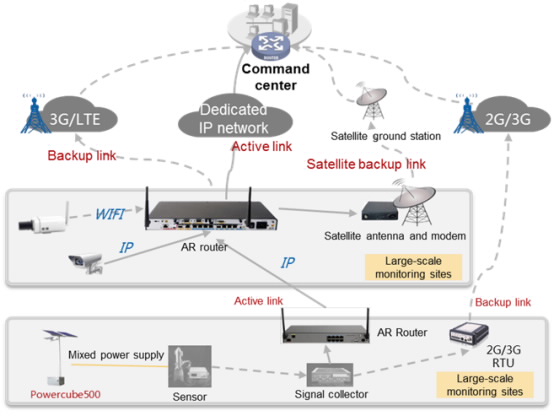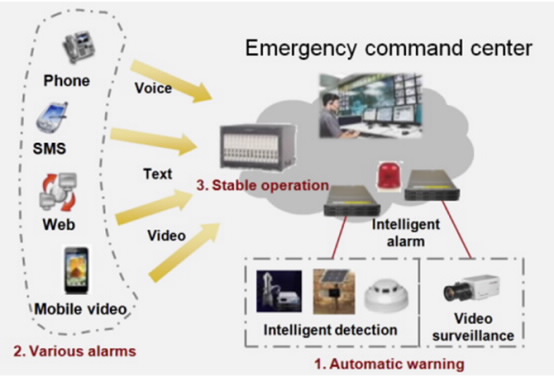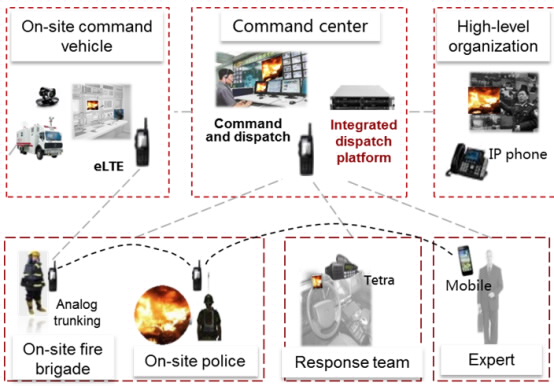Today’s after-incident response mechanisms lack the unified communications and command tools to respond quickly to emergencies. To better manage natural disasters and accidents, governments need a comprehensive solution that supports video surveillance, incident reporting, and command and control. Some of the major challenges to achieving this are:
- Lack of efficient surveillance, including blind spots and poor image quality, forces governments to respond passively to incidents, slowing response time
- Incident reports are typically processed via voice calls. During a major incident phones may not be available and emergency personnel may need additional details that dispatch cannot provide, reducing dispatch efficiency and increasing response time.
- Communications terminals lack compatibility; for example, a video conferencing system can’t integrate with a video surveillance system, hindering inter-agency cooperation
- Emergency communications networks in use today have limited bandwidth and lack reliable mobile emergency communications support, which reduces the efficiency and effectiveness of emergency response
- Incident receiving centers located in different regions have unbalanced workloads — when faced with a service surge, the system cannot respond to incidents in a timely manner
Huawei’s Emergency Communications Solution is designed to meet these challenges by linking surveillance and multi-platform communications devices with mobile and onsite incident processing centers.
The Emergency Communications Solution uses an all-IP network architecture composed of the WAN and LAN. Access modes supported by the solution include microwave, satellite, and wireless access (such as WLAN and 3G) for greater reliability of emergency command networks. This integrated, comprehensive solution includes the following parts:
- Surveillance and warning system, which performs around-the-clock surveillance for monitored areas and generates warnings when detecting exceptions, enabling users to make appropriate preparations before an incident occurs
- Incident receiving, which uses a holistic, IP-based system for incident reporting and coordination of emergency resources
- Command and control, via unified voice and video dispatching that regulates communications between the command center, dispatch center, and incident sites, ensuring incidents are processed in a timely manner
Emergency Communications Solution Overview Diagram

View events and respond to incidents quicker with surveillance and warning tools
The Huawei Surveillance and Warning system uses wired and wireless network coverage to collect surveillance and signal data and employs a hybrid power supply system (solar/electric/diesel) to ensure around-the-clock operation. The video system seamlessly connects to the emergency response system, enabling connections to video applications through wireless networks to help management personnel make quick and accurate decisions. Data is placed in a cloud data center, enabling massive amounts of data to be stored, analyzed, and backed up for disaster recovery.
Surveillance and Warning System Diagram

Obtain accurate location information with the Huawei incident receiving system
The Huawei Incident Receiving system supports multiple modes of receiving alarms including text, voice, video, PTT, and web. Once an alarm is raised, the solution uses base stations and fixed networks to quickly locate where the alarm originates. Distributed alarm receiving centers help to efficiently balance workloads among different regions during large incidents so emergency response systems don’t become jammed when they are most needed.
Incident Receiving System Diagram

Connect emergency personnel with key decision makers using the Huawei command and control system
Huawei’s Command and Control system merges video conferencing with an all-digital video surveillance system, enabling visual dispatch. Emergency responders using mobile, analog, or PTT devices are connected with one another by Huawei’s integrated dispatch platform that uses eLTE and TETRA mobile stations and mobile command vehicles. The high bandwidth needs of all these devices are met by connecting them with LTE trunking that also help precisely locate emergency personnel. To eliminate communications interruptions between emergency sites and command centers, data backhaul is supported with microwave relays and satellites.
Command and Control System Diagram

The Huawei Emergency Communications solution enables governments to achieve unified, flexible, coordinated, and efficient emergency responses with improved incident-handling capabilities.
- Establish unified communications instantly, anywhere, anytime with vehicle-mounted command systems, portable cluster sites, and mobile video surveillance systems
- Stay connected using multiple modes of communications including instant message, voice call, and web that provide detailed info on where incidents occur and won’t jam when you need them the most
- Make quick and accurate decisions using the multimedia dispatching platform that seamlessly connects to the emergency response system, enabling voice and video dispatch network-wide
- Improve collaboration between emergency responders and dispatch with a high-capacity emergency private network that ensures highly available communications and supports massive data processing
Get started on a safer tomorrow today by Contacting a Huawei Safe City Solutions Partner or Email Us for more information.




